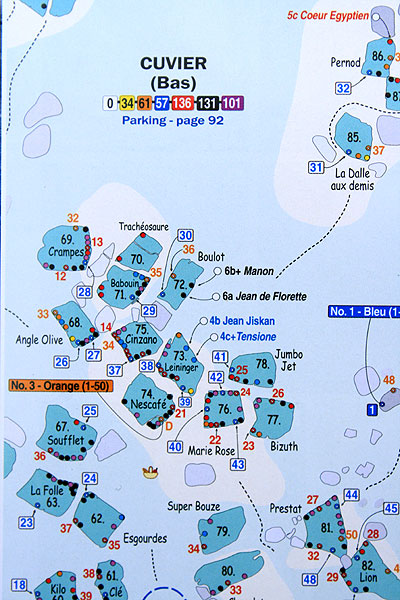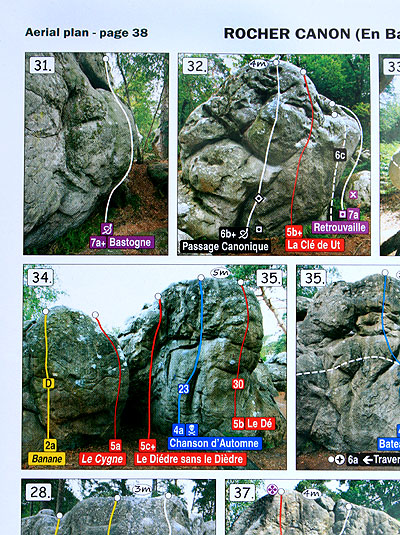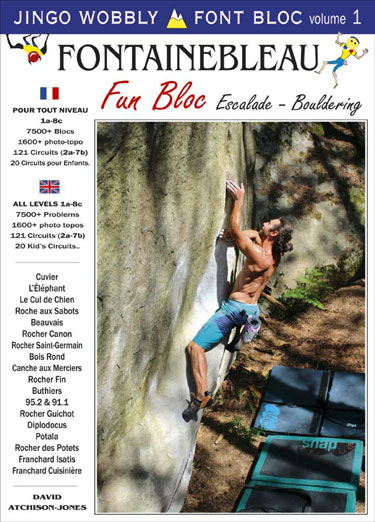 |
|||||||
|
|||||||||||||||||||||||||||||||||
FONT BLOC 1 - FONTAINEBLEAU
FUN BLOC
This is our very popular bouldering guidebook to the very best spots in Fontainebleau. We would reccomend this book to everyone - both as a starter book for those new to Fontainebleau, as well as climbers using grade 7+8, since the maps and photo topos are of tremendous help when using more specific other guidebooks. Fun Bloc is regularly updated with circuit changes and grade adjustments. The book is perfect for the single climber on their own, as well as universtity - large groups - who usually require a large concentration of problems across all grades.
ALL LEVELS - PHOTO TOPOS
The book includes the top 25 locations where all of the blocs are close together and easy to access. Every bloc in these areas is covered comprehensively. They are all included on precise aerial maps for a perfect overview, and most have full photo topos which make problem identification easy.
HOW LARGE IS FONTAINEBLEAU
The Forest is gigantic, and very very confusing. Out of the 900 square km, there is only climbing in 120 sqm, so you can very easily get lost in the remaining 780 sqm. It takes many years to get familiar with the most popular spots, and for the quieter areas - you often forget the access approach. Having a book with over 1600 photo topos is essential so that you can properly recognise all of the major boulders in a particular area.
PROBLEM DEFINITION
We use the traditional colours in the names of the routes and for the precise grades (coloured lines just make the lines clear but do not represent difficulty). Starting handholds and footholds are indicated on problems - where there could be confusion. We also have an adjustable dot before the grade to indicate if the grade is for a short, medium or tall climber.
OTHER JINGO WOBBLY GUIDEBOOKS
See our Volume 2 - Top Secret.
TRAVEL & CAMPING
All of the useful campsites (5) in the area are illustrated on the maps, along with details of facilities. Wild camping in the forest is not allowed, so please do not use the car parks as a campground.
JINGO WOBBLY BOOKS - COPYRIGHT: All the photographs in our books are copyrighted, along with all the text and topo drawings. We visit all the cliffs included in our books, and make all the topo drawings ourselves by hand.
|
International topo guidebook FONT BLOC - VOLUME 1 FONTAINEBLEAU - Fun Bloc 5th Edition - ISBN 978 1 873 665-15-2 32.50 Euros 320 pages, 210mm x 151mm Two languages: French & English Graphics and photo topo guidebook that will suit all languages. 46 Different climbing locations 7500+ Boulder problems 1a-8c (Bloc grades) 1600+ Colour photo topos |
|
||||||||||


GENERAL INFORMATION FOR BOULDERING AT FONTAINEBLEAU:
GEOLOGY: The rock is sandstone and varies in consistency. In some parts it hardly holds together, so is not ideal for bouldering. Fortunately in most parts, it is very strongly bonded and is ideal for bouldering - giving enough friction - but not too much. The type of sandstone found in Font is rare, because it comes from a limestone sandwich, unlike the majority of sandstone found elsewhere around the world. In general terms, the sandstone was formed over a flat sea of limestone, to form a relaitvely thin crust. Then another layer of limestone was formed on top, compressing the sandstone. The genius part thereafter was a slight bending of the earth, so the sandstone shattered like cobbles between the two limestone layers. With water and other elements flowing through, a lot of the cobbles formed layers of quartz on their outer sides. Eventually the top layer of limestone wore away and the result was thousands - if not millions, of blocks were left, covered in highly protective quartz. All of the softer sandstone blocks have been eroded away, and it is the more dense ones that are left. So essentially climbing at Font is bouldering on blocks of sandstone with tiny flakes of quartz. On the hardness scale where steel is 4 and diamond is 10, .Quartz comes in at 7, so when the rock polishes from the tiny grains of quartz-sand deposited from the soles of your climbing shoes and ground in, there is nothing on earth - apart from sapphire and diamond that will unpolish the holds. Tree resin used locally (pof), to make climbing more pleasureable is biodegradeable and has a hardness of 1, so anyone telling you that the holds are polished by resin - is taking you for a complete pratt - idiot - numpty - call them what you want to. Major outcrops like Cuvier and Cuisiniere have highly dense sandstone. Gros Sablons in the book Top Secret, is very high in quartz and feels like skating on glass which can be incredibly disconcerting, especially as the boulders are very high too. The most dense rock is generally found in a middle band running through the whole area, with outcrops in the south like Elephant, and Padole in the North - having much softer rock. However there are superb exceptions such as Troglodyte (Top Secret) and Beauvais (Fun Bloc) that have dense rock too. So in general, always use a crash pad, and take a small piece of carpet to stand on before you start a problem, so you leave the ground with perfectly clean shoes and therefore do not add any extra polish to the footholds. (Clean your shoes before you step onto the carpet). Also this is useful since quite often the start of the problem - is not actually the centre of the fall zone, and if you are intelligent - you will place your crash pad at the centre of the likely fall zone. Chalk (Mag carbonate) versus Pof (resin), both are great - enjoy. Just clean off anything visible after and make tick marks as tiny as possible, top tip - climb very precisely at Font - it works.
CRASH PADS: There are so many types of crash pad on the market - which one to buy or should I rent one in Font. A huge influence in the choice is the level that you climb, and where you are climbing. If you are new to bouldering in general and are going to the areas in Fun Bloc, then one pad - any style, is sufficient. You can take your own or rent one. There are lots of places that rent pads, most of the campsites, Pizza shop in Arbonne le Foret, Scape climbing shop in Fontainebleau, and many gites also rent out pads. Usually it only adds a small cost to the whole trip, and travelling by air - its a must anyway. As soon as you start to climb in the blues and reds, unless the landing is flat - then 2 pads are going to be highly desireable, and I personally would say essential. From here it becomes technical. Spotting someone onto sloping ground, is the quick way to get a thump in the face by a stray arm. Best tip is to use one pad to level the ground, then place the other on top to make the area nice and level. This way you can spot the climber into the soft zone, and they will compress onto their own legs naturally. So the extra pad is ideally a triple pad, so you can have a single part, then double part, which when covered with a top pad - gives you single, double, triple and a flat landing zone.There is also a small triple pad that folds in a Z section, made by the local Font company BBZ. This is great for doing a circuit where you are constantly picking up the pad and moving from problem to problem. It is lightweight to carry, easy to pass between blocks, and makes a day out so enjoyable. The compromise is its thin foam and lighter nylon that wears a lot quicker. When you climb higher problems (4m and above), you really do need a good thick pad, if not 2. Any grade 6 local climber will use a beefy pad around 10cm thick, and a good big area. You can buy these but they are not easily available to hire, a typical example is the one from Cassin with a large domino pattern on. Ocun make a pad with a zip so you can use for a drop or a traverse. Can be nice, but for most of the time on a traverse you are not going to fall off, and it is pretty easy to identify the tricky part of the traverse and any normal pad will do fine (this said - the Ocun pad is really good anyway). When you go up into the grade 7, most climbers go for the giant pads. These are quite simply fabulous, but unless you are going to stay on the same problem all day - a nightmare. So in general there is no obvious answer. Best thing is to go in a group and a have a good selection of pads between you all. Certainly always take a pad each, there is nothing more annoying than not having your own pad at Font, and if you join a group of climbers on a problem and add another pad - you are always welcome!
TRAVEL TO FONT: Car is the best recommendation. 900 square km, so that says it all, and 780 empty sq km with no boulders. The areas in Fun Bloc are very highly concentrated, so once you get to them, sure you don't need a car all day. Cars do get broken into at the quiet forest parking areas, so most climbers leave them open and completely empty. If you don't have a car, then fly to Charles de Gaulle airport in the North of Paris, rent a car for your duration at Font. Paris traffic is a nightmare, so leave plenty of time. There are 3 ring roads, Pereferique in the centre - really bad, A 86 a mid connetion - not so bad but not good, and the N104 very outer ring road - this is best but gets very snarled up as it crosses the A4, and also has some big shopping centres on it - so not ideal either. Arbonne le Foret in the centre of the forest always has speed traps and alcohol testing, so best not to take any chances and keep the mad attitude to the climbing. If a car is not possible, then the only sensible option is to stay at Musardiere Campsite, where you can walk to the climbing in the Trois Pignons. Only way there is by taxi from Font Avon Station.
BEST TIME TO VISIT: Everyone has a different take on this for sure. The only agreement is that Font in the rain is pants, so do your own research and go when it is dry, best piece of advise. My friends climb 8a in 30 degrees in the summer, plenty of shade, others love crisp dry rock at 4 degrees. Hot days are never a problem, you can always find cool places, and some areas only dry out in hot spells anyway. Mornings are always cool, especially with a moonlit night. The only really bad time is when a big anticyclone comes over and you get 4+ hot days in a row, this is not that enjoyable. If it does get hot, Musardiere Campsite has the best swimming pool. At Gres sur Loing there are always people swimming in the river, also at Nemous and Moret sur Loing.
HOW LONG TO GO FOR: A week is the standard good trip, that allows you to lose some time to rain, and give you 5 good days. You probably can only climb for 4 days since your body will be wrecked by only one day at Font. If you can go for a week, only climbing half a day on your first day is sensible - but rarely done!!! Keep a good eye on your fingertip skin. If you go through this, then it really does bugger up the rest of the trip. If you dyno to a hold, only grip when you really do have the hold - otherwise you will lose your skin in 30mins. Do a variety of problems that uses differernt techniques so that you get good use out of all your different body muscles, and wear skin in all different ways. If you need to tape up a finger for skin wear (not tendon problems), start on the middle part and wrap out to the end of the finger. This way the tape does not come off. You loose sensation in the feel of the skin, but it can really save the trip. Doing a whole circuit one day is great fun, and pick an easy one. After 40 problems you will be so so tired, so even the grade 4's will be testing. It also gives the skin a great rest day. Weather is also very local throughout the forest, so it can be dry in the South or East, and raining in the North or West. Any combinatin is possible, so unless the weather is obviously bad everywhere - maybe think of trying somewhere else in the afternoon.
WHERE DRIES QUICKLY: Everywhere if the wind is blowing in the right direction. The key element is the wind - simple as that. No wind - go to the bar. Big wind, get up high. This also applies to mosquitos. They don't like wind, so those east facing hollows on a damp afternoon - are very ugly indded. Have a great trip to Font and let us know if you want anything more on this page. Jingo and Wobbly.
